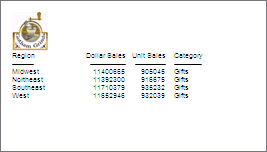In this section: |
With PowerPoint (PPTX), Microsoft® introduced enhanced functionality in a new presentation file format. WebFOCUS Release 8.0 Version 08 introduces the capability to retrieve data from any WebFOCUS supported data source and to generate a PPTX presentation for data analysis and distribution.
The PPTX format generates fully styled reports in binary display format, which uses the same binary technology that is used for XLSX. When PPTX is specified as the output format, a PowerPoint presentation with a single slide that includes the report is created.
The WebFOCUS procedure generates a new presentation containing your defined report elements, such as headings and subtotals, as well as StyleSheet syntax, such as conditional styling and drill downs.
Additionally, you can add multiple graphs and images to a PowerPoint presentation. The PowerPoint output format can contain a variety of graphs positioned anywhere on a slide to create a visual layout.
You can place report output on a specific slide in a PowerPoint template. This enables you to populate existing presentations with preset Slide Masters, styling, and other business content. PowerPoint design templates (POTX) and PowerPoint macro-enabled templates (POTM) are stored on the server and can be distributed automatically with ReportCaster.
ON TABLE {PCHOLD|HOLD|SAVE} [AS name] FORMAT PPTX
[TEMPLATE {'template.potx'|'template.potm'} SLIDENUMBER n]
where:
- name
-
Is the name of the PowerPoint output file.
- template
-
Is the name of the PowerPoint template file. The template file must have at least one blank slide and must be saved as a .POTX or .POTM extension on your WebFOCUS Reporting Server application directory.
Note: Since different extensions are supported for PowerPoint templates, it is recommended that you include the extension in the name of your template.
- n
-
Is the number of the slide on which to place the report output. This number is optional if the template has only one slide.
The following request against the GGSALES data source inserts a WebFOCUS report into a PowerPoint PPTX template named mytemplate.potx which is stored in the application directory:
TABLE FILE GGSALES HEADING " " " " " " " " " " SUM DOLLARS UNITS CATEGORY BY REGION ON TABLE SET PAGE-NUM NOLEAD ON TABLE NOTOTAL ON TABLE PCHOLD FORMAT PPTX TEMPLATE 'mytemplate.potx' SLIDENUMBER 3 ON TABLE SET HTMLCSS ON ON TABLE SET STYLE * TYPE=REPORT, FONT=ARIAL, SIZE=10,$ TYPE=HEADING, image=gglogo.gif, POSITION=(0.000000 0.000000),$ ENDSTYLE END
The output is:
